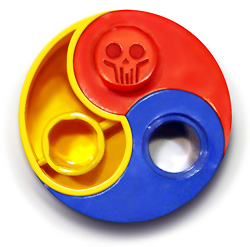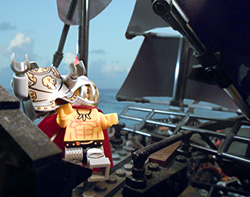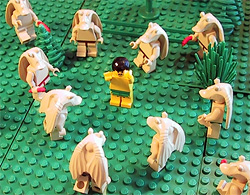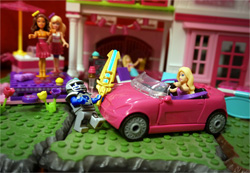|
Chapter Four The Player Turn  The BrikThulhian Troika can be thought to represent the cycle of movement, Action, and response. But on the other hand it can really be thought to represent just about anything.
own photo Uploaded, final
During a player's turn, each of their units may engage in whatever movement is allowed by its Move attribute, and may take one major Action (preferably an attack). Meanwhile, other players' units with unspent Actions can use them in response to the active player's offensive behavior. During movement, a minifig's Move rating of 5" allows him to move five inches in any direction. He can run across five inches of level ground, climb five inches' worth of stairs or ladders, or leap over five inches of chasm. His movement is limited in a couple of ways. He can't pass through solid obstacles or leap higher than 1" (three bricks) in a single jump. Difficult types of movement might slow the minifig to Half Speed. Movement that requires the use of one or both arms (swimming, crawling, climbing ladders, or swinging on ropes, for example) will prevent the minifig from using those arms to make attacks or perform other manual Actions. If a minifig moves within Close Combat striking distance of an opposing minifig who still has an Action to spend, the opponent automatically attacks him, unless the opposing player says otherwise (4.3: Enemy Response). If the minifig decides to Parry the attack, they are both entered into Close Combat and the minifig's movement is over for the turn (5.2: Close Combat). If he declines to Parry and survives, he can ignore the attack and continue moving normally.  own drawing Uploaded, final
A minifig is not always able to run around at full speed. Difficult conditions or activities can slow him to Half Speed or Stop his movement entirely for that turn. If he's taken violently off his feet, whether by a Shove, an Explosion, or from desperately Bailing out of the way of impending destruction, it will cause him to become Disrupted and defenseless until his next turn.
Activities marked with a
 With his ship taking heavy damage, Oscar the Strong decides to remove his armor rather than risk drowning if it sinks.
image rights: Scratch Uploaded, final
Although a minifig can only take one major Action per turn, there are lesser activities that are too minor to count against this limit. Activities that require no particular attention, aiming, or dice rolls are either free or treated as an impairment to movement rather than spending the minifig's Action. Simple acts, like picking up or dropping objects, holding conversations, or sneezing don't slow a minifig down at all. More strenuous activities may reduce a minifig's movement to Half Speed, Stop them completely, or leave them Disrupted.
 Unarmed, naked, and surrounded by sausage-wielding Dungans, this minifig's best option is to Sprint like hell and never look back.
image rights: Shaun Sullivan,
When speed is critical, a minifig (or any mobile unit) can spend his Action to Sprint, rolling his Action Die and giving himself that many bonus inches of Move. After pointing himself in the right direction, the minifig's entire movement for the turn (including the Sprint) must be in a straight line forward. His path may go up or down and over any obstacles that he can leap over without having to stop and climb, but it may not turn to the right or left by even a tiny amount. Sprinting minifigs may not engage in any activity that would break their run, like opening doors, typing in security codes, or taking naps. Minifigs moving at Half Speed can put in the extra effort to Sprint, but the extra Sprint inches are also at Half Speed. Sprinting can be combined with a Charge attack (5.4: Charge!) as part of a single Action. Minifigs Sprinting in a group can roll a single Action Die for the entire group's Sprint distance, for the sake of convenience. The die roll for Sprinting can benefit from Bonus Dice like any other roll (1.2: Numbers) — the extra dice keep adding more inches to the Sprint, allowing truly ridiculous straight-line speed. By tradition, if a series of Critical Successes in a Sprint roll ends with a roll of one, it's a special kind of Critical Failure: the minifig is unable to stop himself, and must run the full distance allowed by the extra Bonus Dice, even if he runs into a wall or off the table. Any act that requires a minifig's focused attention or concentrated physical effort is an Action. Due to the limitations of time and plastic brainpower, a normal minifig is limited to one Action per turn. He can use this single Action before, after, or in the middle of his movement, but he only gets one, so he should spend it wisely (which is to say, as unwisely as possible). His spent Action recharges at the beginning of his next turn. In ideal circumstances, a minifig will use his Action to make attacks (5.1: Making Attacks). But even the most belligerent minifigs will concede that less violent Actions are sometimes called for in order to set up even more violent Actions later. Minifigs are clumsy and easily distracted, and Actions are rarely automatic successes. Each Action is given a Use rating describing its relative difficulty. Except for the most trivial Actions, a minifig attempting an Action must make an Action Roll, rolling his Action die to see if his attempt succeeds. If his Action Roll is equal to or higher than the Action's Use rating, then the Action succeeds. If it's lower, the Action fails, and the minifig suffers whatever consequences logically result.  In BrikWars, God doesn't play dice — dice play God. The Dodekube cultists of Opus Die believe that logic is an illusion and that reality is nothing more than the cosmic dice rolls of disinterested Human overlords. Their heretikal beliefs arise from the fact that even the most sober minifigs have sometimes "seen the dice." own illustration Uploaded, final
Weapons and other equipment items are given Use numbers in their descriptions (Chapter Three: Minifig Weapons). A minifig attacking with or utilizing one of these items rolls his Action Die against its Use number. Besides weapon attacks, there are lesser alternate tasks that minifigs might attempt, ranging from trivial to impossible. Most will have a default Use rating of 3; players may agree on a higher or lower difficulty as seems appropriate. For truly exceptional Actions, the Use requirement can be so high that minifigs may need one or more Bonus Dice to have any chance of meeting it. No matter how minor or Herculean an Action may be, a minifig of unusual skill or luck can find ways to execute it with extra flair. An Action Roll doesn't score Critical Successes the same way as other die rolls (1.2: Numbers). Instead, any time a minifig rolls a six or higher on his Action die (before adding or subtracting any modifiers) to perform an Action, he can take the Action Over the Top. An Over the Top Action can only be earned by the Action Die in an Action Roll. Action Dice rolled for other reasons (e.g., in Damage Rolls for Close Combat weapons) score regular Critical Successes instead, as do other dice added to an Action Roll as Bonus Dice. While a six is the highest number a normal minifig can naturally roll on his Incompetent units with an Action Die of When a minifig goes Over the Top with an Action, he receives a special Bonus Die, called a Benny, to amplify that Action. An Over the Top Benny can be spent to add +1 If the Over the Top Benny is used to add Damage to an attack, it adds one more of the attack's existing Damage dice. A
1 Regardless of Action or Damage type, rolling a Critical Success on an Over the Top Benny die adds a +1
A minifig taking an Action Over the Top doesn't have to add a die to a stat. He can use it to embellish his Action in any way the other players agree to. An Over the Top Benny might be spent to avoid a negative consequence, such as allowing a Bailing minifig to land acrobatically and avoid being Disrupted (4.3: Enemy Response). An Over the Top Benny might also be used to make an attack more precise: a minifig might spend it to change "I was shooting at the dragon" to "I was shooting at the dragon's left eye," if his original Action Roll was high enough to hit the eye despite the penalties for small target size. Some Actions are so involved or time-consuming that they take up a minifig's entire turn, even if they aren't difficult enough to require an Action Roll. These full-turn Actions include piloting a vehicle, operating a computer, putting on a suit of plate mail, rowing a rowboat, or reading a wargaming rulebook. Once engaged in a full-turn Action, a minifig is Stopped and can't engage in any other type of Action or movement of his own for the rest of the turn, although he may still be moved around by vehicles or other units (for instance, if he's using a full-turn Action to ride a Horse). A full-turn Action that extends over multiple turns is an extended Action. The most common extended Action for minifigs, often extending over a very large number of turns, is "Being Dead." If a minifig doesn't spend his Action on his own turn, he can save it to use in response to other units' activity. A minifig can use a response Action to fire at gunmen as they pop out from behind cover, to whack a soldier that strays into range of his two-by-four, or to pull the self-destruct lever at the exact moment when the final invitees have boarded the cruise liner for his birthday party. Of course, his enemies are just as free to use saved Actions during his turn as well, so he should tread carefully. To take a response Action, a minifig must have an unspent Action from his previous turn. He can move up to one free inch (known as an Angry Inch (5.2: Close Combat)), if necessary, in order to grab, operate, or otherwise interact with a critical object (to pull a lever or kick over a table for cover, for instance), or to position himself to make a Close Combat or Ranged attack. An Angry Inch doesn't cost any Move inches. A responding minifig must be aware of the specific Action or movement he's reacting to, and in a timely enough fashion to make a proper response. In most cases, this means he has to be able to see it. If he sees an enemy soldier raise a rifle and take aim, he may have time to dive for cover. If all he knows is that he heard a gunshot, it's too late. A minifig's cone of vision points in whichever direction his head is facing, and forty-five degrees to either side, making a complete cone of ninety degrees. If an object or event is within that field of view, the minifig can see it. If not, he can't. If it's hard to tell whether an object falls within that cone, a quick What I Say Goes Roll will resolve the issue. Even if a minifig can see disaster about to strike, he won't always be fast enough to respond in time. In some cases, a minifig will have plenty of time to make a response Action. If an enemy is running up with a knife while the minifig's swinging a polearm, or if the enemy's running up with a polearm while the minifig is aiming a pistol, or if the enemy's running up with a pistol while the minifig's hiding in an underground bunker with a hand on the magma release lever, the minifig is going to have plenty of time to act before the enemy gets close enough to do anything about it. If a minifig is able to act or react while his opponent is still an inch or more away from acting himself, then the minifig acts first. Otherwise, both Actions occur simultaneously if possible, and with the higher Action Roll going first otherwise.

Long before he became the Emperor of Akkadia, the feats of Piltogg were already legendary. Strengthened by the secret art of Running Five Miles, Piltogg was able to Bail out of a deadly NegaBlok collision in an event known as That Time He Got Hit by a Car but Rolled Out of It.
From "Path to the Grail, continued" Elements shown: LEGO, Mega Bloks own photo Uploaded, final
The preferred response to any enemy activity is to attack with every available weapon, whether they’re mounting a cavalry charge, offering a surrender, or leaving cookies out for Manly Santa. Nonetheless, there are times when a minifig's best bet is to make a desperate leap for safety. He may be dodging an oncoming truck, jumping out of an exploding helicopter, or diving behind cover when an enemy gun turret opens fire. Minifigs are not able to Sprint as a Response Action. Instead, assuming their movement type would logically allow it, they have the option to Bail. A Bailing minifig can spend an Action to dive to any spot within an Action Roll's worth of inches from his current position, ending up lying prone on the ground and Disrupted.
A minifig who's reduced to Half Speed also Bails at Half Speed, diving only one real inch for every two Bail inches. If a minifig is at Half Speed because he's carrying a heavy burden, he can drop it before he Bails and leap the full distance. A low Action Roll can sometimes mean that a minifig doesn't Bail far as he needs to, and a Critical Failure means he just slips and falls on his face right where he's standing. If a Bailing minifig doesn't jump far enough to escape the path of an oncoming train, he still gets hit by the train; if he's Bailing to avoid a rifle volley and doesn't reach cover, the riflemen just fire at him in his new position instead of his old one.
| |||||||||||||||||||||||||||||||||||||||||||||||||||||||||||||||||||||||||||||||||||||||||||||||||||||||||||||||||||||||||||||||||||||||||||||||||||||||||||||||||||||||||||